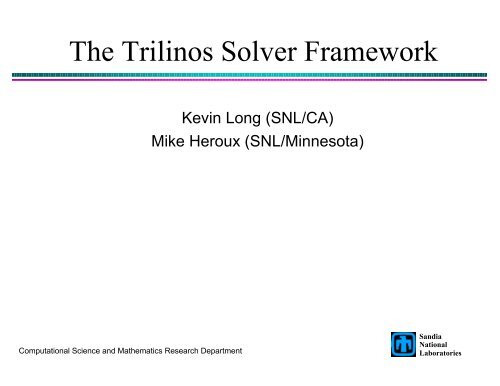The Trilinos Solver Framework
The Trilinos Solver Framework
The Trilinos Solver Framework
- No tags were found...
Create successful ePaper yourself
Turn your PDF publications into a flip-book with our unique Google optimized e-Paper software.
<strong>The</strong> <strong>Trilinos</strong> <strong>Solver</strong> <strong>Framework</strong>Kevin Long (SNL/CA)Mike Heroux (SNL/Minnesota)Computational Science and Mathematics Research DepartmentSandiaNationalLaboratories
<strong>Trilinos</strong> Project Overview• PI: Mike Heroux• http://www.cs.sandia.gov/<strong>Trilinos</strong>/EPetraCore matrix-vectorAztecOOAztec wrappersIFPackIncomplete factorizationsNOXNonlinear solversMLAlgebraic MultilevelTSFHigh-level interfaceComputational Science and Mathematics Research DepartmentSandiaNationalLaboratories
TSF• Interface for representation-independent solvers• Abstract interfaces for vectors and operators• Composable operators• Block operators• Design goal• Matlab-like simplicity, running on a supercomputer• High-level conveniences• Minimal-overhead operator overloading• Transparent memory management• Many design ideas derived from Gockenbach and Symes’ HilbertClass LibraryComputational Science and Mathematics Research DepartmentSandiaNationalLaboratories
Simple example: a representationindependentconjugate gradients solverComputational Science and Mathematics Research DepartmentSandiaNationalLaboratories
written with block and composedoperatorsComputational Science and Mathematics Research DepartmentSandiaNationalLaboratories
Operator overloading can be made fast• Overloaded TSFVectoroperations are deferred• Alternative to expressiontemplates• Temporaries areunavoidable with overloadedC++ operators• Result of each binaryoperation is a deferred linearcombination object• Carry out actual calculationsonly when necessaryComputational Science and Mathematics Research DepartmentSandiaNationalLaboratories
<strong>The</strong> overhead incurred by using TSF isnegligible in a linear solve• Figure shows low-level Epetra and BLAS times relative to total TSF solvetime.• Poisson solved with TSF BICGSTAB and ILU(1)• TSF and operator overloading overhead is < 5% for problems larger than N~1500Computational Science and Mathematics Research DepartmentSandiaNationalLaboratories
A short TSF tutorial• About the code• Creating vectors and matrices• Filling a matrix with values• Building complicated linear operators• Preconditioners and Preconditioner Factories• Linear solvers• Nonlinear operators• Nonlinear solversComputational Science and Mathematics Research DepartmentSandiaNationalLaboratories
General code style; TSF is in C++; User-level objects such as TSFVector, TSFLinear<strong>Solver</strong> arehandle classes» At the user level, vectors are created from the createMember() methodof vector space» Create objects such as solvers from a concrete type as follows:TSFLinear<strong>Solver</strong> solver = new BICGSTAB<strong>Solver</strong>(...):; Concrete implementations, e.g, PetraVector, derived fromextensible base classesComputational Science and Mathematics Research DepartmentSandiaNationalLaboratories
Use TSFVectorType and TSFVectorSpaceobjects to create vectors and matrices of aspecified typeComputational Science and Mathematics Research DepartmentSandiaNationalLaboratories
TSF provides an interface forconfiguring and loading a matrix; First build the matrix as shown previously; Next, configure the matrix» setColumnSize()» freezeStructure(); Load the values» setRowStructure() and addToRow() for each row; Finalize the matrix, distributing ghost rows» freezeValues()Computational Science and Mathematics Research DepartmentSandiaNationalLaboratories
Adjoint, inverse, and adjoint-inverseoperators can be created at a high level•TSFAdjointOperator applies the adjoint of another operatorTSFLinearOperator adj = new TSFAdjointOperator(A);or more simply,TSFLinearOperator Aadj = A.adjoint();•TSFInverseOperator applies the inverse of another operatorusing a specified solver. <strong>The</strong> inverse is never formed.TSFLinear<strong>Solver</strong> solver = new BICGSTAB<strong>Solver</strong>(...);TSFLinearOperator Ainv = A.inverse(solver);•TSFInverseAdjointOperator applies the inverse adjointTSFLinear<strong>Solver</strong> solver = new BICGSTAB<strong>Solver</strong>(...);TSFLinearOperator AinvAdj = A.inverseAdjoint(solver);Computational Science and Mathematics Research DepartmentSandiaNationalLaboratories
Overloaded operators are used to formefficient compound operators; Operator composition with overloaded *, e.g. A*B*C; Operator addition with overloaded + and -, e.g. A-B; Scalar multiplication with overloaded *, e.g, a*A; All of these are implemented without forming the explicitmatrix product or sumComputational Science and Mathematics Research DepartmentSandiaNationalLaboratories
Linear solvers in TSF• class TSFLinear<strong>Solver</strong>• Iterative solvers are simple tocode in TSF using overloadedvector and matrix operations.– Currently, we have implementedBICGSTAB, CG, GMRES, andan interface to AztecOO– Flexible Krylov methods (FCG,FGMRES) implemented by V.Howle, used for fault-tolerantlinear algebra– Block Krylov methods beingimplemented by M. Heroux andT. Barth• Direct solvers can beimplemented for matrix operatorsonly• Block solvers, e.g. Schurcomplement, block backsolve canbe implemented matrix-freeComputational Science and Mathematics Research DepartmentSandiaNationalLaboratories
Preconditioning• TSFPreconditionerFactory builds a TSFPreconditioner for agiven operator• TSFPreconditioner has left() and right() methods to accessoperators.Computational Science and Mathematics Research DepartmentSandiaNationalLaboratories
PreconditioningComputational Science and Mathematics Research DepartmentSandiaNationalLaboratories
Example: creating a Kay-LoghinpreconditionerComputational Science and Mathematics Research DepartmentSandiaNationalLaboratories
Current status; Concrete types» Epetra and LAPACK vectors andmatrices; Matrix-free types» block, sum, product, diagonal,zero, and identity operators; Preconditioners» IFPack» User-defined blockpreconditioners; Linear solvers» BICGSTAB, GMRES, CG, FCG,FGMRES» AztecOO» LAPACK direct» Schur complement, block triangularComputational Science and Mathematics Research Department; Nonlinear operators» general nonlinear operatorinterface» Composed operators; Nonlinear solvers» Newton with line search» Picard; Utilities» Controllable error handling anddiagnostic reporting» reader/writer interfaces» Matlab and Matrix Marketreaders and writersSandiaNationalLaboratories
Where is TSF being used?; Sundance» a high-level PDE simulation and optimization package (KL); Split/O3D» a SQP optimization code (Paul Boggs); rSQP++» a rSQP optimization code (Ross Bartlett)Computational Science and Mathematics Research DepartmentSandiaNationalLaboratories
Plans; Development» Broader selection of components AMG preconditioning More solvers» Documentation; Research» Block Krylov methods (Heroux & Barth)» Physics-based preconditioners (Howle, Heroux, KL, Tuminaro)» Fault tolerance (Howle, Hough)» PDE-constrained optimization (KL, Boggs, van Bloemen Waanders,Bartlett)» Preconditioners for inequality constraints (Boggs, Howle, Tuminaro)Computational Science and Mathematics Research DepartmentSandiaNationalLaboratories
Acknowledgements; Helpful design criticism and alpha testing from» Paul Boggs, Ross Bartlett, Vicki Howle; Some examples and tests from» Mike Boldt; Some solvers and preconditioners from» Vicki Howle, George Biros; EPetra vectors and matrices from» Epetra/<strong>Trilinos</strong> development teamComputational Science and Mathematics Research DepartmentSandiaNationalLaboratories
Some pretty pictures fromSundance/TSFContours of vorticity in a lid-drivencavity, computed using the Kay-Loghinblock preconditioner on a Taylor-Hooddiscretization of Navier-StokesTemperature and sensitivity toPeclet number computed with aconvection-diffusion model onthe Sandia ThunderbirdComputational Science and Mathematics Research DepartmentSandiaNationalLaboratories
Formulation and solution of a sourceinversion problem•Simulation written by Omar Ghattas – 120 lines of Sundance code•Advection-diffusion of a contaminant released from a Gaussian source•Concentration is measured at 16 discrete sensor locations•Adjoint formulation of inversion problem for distributed source field•Ill-posed – smoothed with Tikhonov regularization•Non-symmetric block reordering of adjoint and state variablesComputational Science and Mathematics Research DepartmentSandiaNationalLaboratories
















